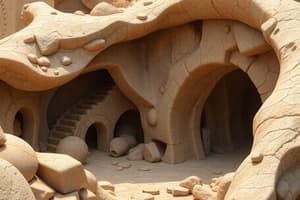Podcast
Questions and Answers
What is a characteristic property of metals that allows them to conduct electricity?
What is a characteristic property of metals that allows them to conduct electricity?
- High melting point
- High ductility
- Low thermal conductivity
- Presence of free electrons (correct)
Hot working processes have no effect on the mechanical properties of a metal.
Hot working processes have no effect on the mechanical properties of a metal.
False (B)
What process involves the rearrangement of metal atoms to relieve internal stresses?
What process involves the rearrangement of metal atoms to relieve internal stresses?
Recovery
The _____ diagram is crucial for understanding the properties of Iron-Carbon alloys.
The _____ diagram is crucial for understanding the properties of Iron-Carbon alloys.
Match the following steel types with their characteristics:
Match the following steel types with their characteristics:
Which of the following manufacturing processes involves melting steel in a very high-temperature electric arc?
Which of the following manufacturing processes involves melting steel in a very high-temperature electric arc?
Wrought iron is a type of steel that contains a very high carbon content.
Wrought iron is a type of steel that contains a very high carbon content.
Flashcards are hidden until you start studying
Study Notes
General Introduction to Engineering Materials
- Engineering materials encompass metals, polymers, ceramics, and composites, each with unique properties and applications.
- Classification of materials includes categories like metallic, non-metallic, natural, and synthetic substances.
- Key properties of materials include thermal (heat retention), chemical (corrosiveness), electrical (conductivity), and mechanical (strength and ductility).
- Selection criteria for materials in industry focus on functionality, cost, availability, and environmental impact.
Structure of Metals and Their Deformation
- Metal structure significantly affects properties such as strength, ductility, and conductivity.
- Basic understanding of atomic arrangement in metals includes face-centered cubic (FCC) and body-centered cubic (BCC) structures.
- Crystal imperfections (defects) like vacancies and dislocations influence a metal’s mechanical properties and performance.
- Deformation mechanisms involve elastic deformation, plastic deformation, and recovery processes.
- Recrystallization is the process where new grains form, enhancing material properties, while grain growth can lead to weaker structures.
- Cold working (deformation at room temperature) increases strength and hardness, while hot working (above recrystallization temperature) improves ductility.
Ferrous Materials
- Pure metal and alloys differ based on elemental composition; alloys provide enhanced properties.
- The Iron-Carbon Equilibrium diagram illustrates the phase transitions and states in iron and steel based on carbon content.
- Manufacturing of pig iron involves smelting iron ore with carbon sources, while wrought iron is further purified.
- Direct Reduced Iron (DRI) or Sponge Iron is produced by reducing iron oxide using natural gas.
- Steel manufacturing methods include:
- Open Hearth Process, a historical method using a regenerative furnace for steel production.
- Basic Oxygen Furnace (BOF), a method where molten iron is converted into steel using oxygen.
- Electric Arc Furnace (EAF), where steel scrap is melted using electric arcs.
- Induction Furnace, utilizing electromagnetic induction for melting metals.
- Steels can be broadly classified into:
- Plain Carbon Steels, primarily based on carbon content.
- Alloy Steels, which contain additional elements for enhanced properties.
- Low, medium, and high carbon steels differ in carbon content, affecting their mechanical properties and applications.
Studying That Suits You
Use AI to generate personalized quizzes and flashcards to suit your learning preferences.




